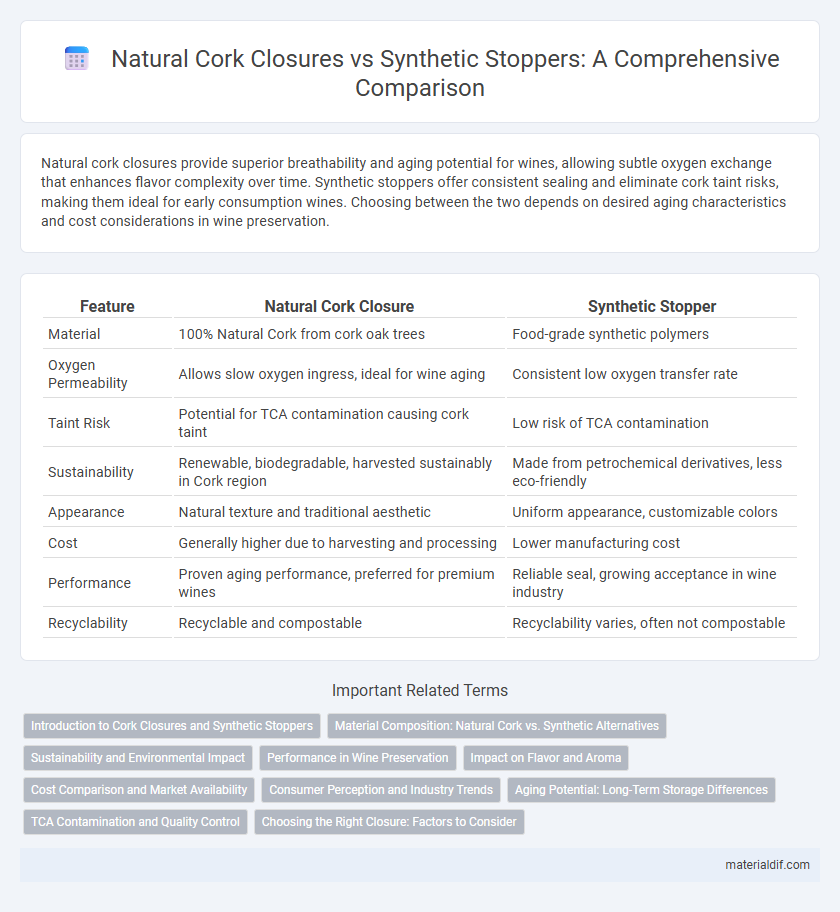Natural cork closures provide superior breathability and aging potential for wines, allowing subtle oxygen exchange that enhances flavor complexity over time. Synthetic stoppers offer consistent sealing and eliminate cork taint risks, making them ideal for early consumption wines. Choosing between the two depends on desired aging characteristics and cost considerations in wine preservation.
Table of Comparison
| Feature | Natural Cork Closure | Synthetic Stopper |
|---|---|---|
| Material | 100% Natural Cork from cork oak trees | Food-grade synthetic polymers |
| Oxygen Permeability | Allows slow oxygen ingress, ideal for wine aging | Consistent low oxygen transfer rate |
| Taint Risk | Potential for TCA contamination causing cork taint | Low risk of TCA contamination |
| Sustainability | Renewable, biodegradable, harvested sustainably in Cork region | Made from petrochemical derivatives, less eco-friendly |
| Appearance | Natural texture and traditional aesthetic | Uniform appearance, customizable colors |
| Cost | Generally higher due to harvesting and processing | Lower manufacturing cost |
| Performance | Proven aging performance, preferred for premium wines | Reliable seal, growing acceptance in wine industry |
| Recyclability | Recyclable and compostable | Recyclability varies, often not compostable |
Introduction to Cork Closures and Synthetic Stoppers
Natural cork closures, harvested from the bark of cork oak trees primarily grown in Portugal and Spain, offer superior breathability and traditional appeal, making them a preferred choice for premium wines. Synthetic stoppers, made from polyethylene or other plastics, provide consistency in sealing and are less prone to issues like cork taint, appealing to mass-market and environmentally conscious brands. Both closure types impact wine aging and flavor preservation, with cork closures enhancing oxidation-controlled maturation and synthetic stoppers ensuring a neutral, non-reactive barrier.
Material Composition: Natural Cork vs. Synthetic Alternatives
Natural cork closures are made from the bark of the Quercus suber tree, offering a biodegradable, renewable material with unique cellular structure that allows micro-oxygenation, essential for aging wine. Synthetic stoppers are composed of various plastics, such as polyethylene and EVA, engineered to mimic natural cork's sealing properties but lack the natural porosity and environmental benefits. Material composition impacts wine preservation, with natural cork supporting slow oxygen exchange while synthetic alternatives provide uniformity and resistance to cork taint but less sustainability.
Sustainability and Environmental Impact
Natural cork closures are highly sustainable due to their renewable harvesting from cork oak trees, which absorb significant amounts of CO2 and support biodiversity in Mediterranean ecosystems. In contrast, synthetic stoppers, typically made from plastic-derived materials, have a larger carbon footprint and pose challenges for biodegradability and recycling. Cork's ability to be sustainably extracted without harming the trees ensures long-term environmental benefits, making it a superior choice for eco-conscious wine packaging.
Performance in Wine Preservation
Natural cork closures provide superior oxygen permeability, allowing gradual aging and complex flavor development in wine, which enhances preservation quality over time. Synthetic stoppers offer consistent sealing performance by minimizing oxygen ingress, effectively preventing wine oxidation and spoilage for short- to medium-term storage. Studies reveal that natural cork maintains wine integrity better in traditional cellaring, while synthetics are advantageous for wines intended for immediate consumption.
Impact on Flavor and Aroma
Natural cork closures preserve wine's flavor and aroma by allowing gradual oxygen exchange, which enhances complexity and aging potential. Synthetic stoppers often limit this micro-oxygenation, risking flavor flatness and less nuanced aromas. Wines sealed with natural cork typically exhibit more vibrant bouquet and balanced taste profiles compared to those with synthetic closures.
Cost Comparison and Market Availability
Natural cork closures typically cost between $0.20 and $0.50 per unit due to the harvesting and processing involved, while synthetic stoppers range from $0.10 to $0.30, offering a more affordable option for mass production. Market availability favors synthetic stoppers as they can be produced year-round without dependency on cork oak harvest cycles, whereas natural cork is limited by geographical and seasonal factors in regions like Portugal and Spain. The demand for eco-friendly solutions is increasing pressure on both industries to balance cost efficiency with sustainability and product quality.
Consumer Perception and Industry Trends
Natural cork closures maintain a strong preference among wine consumers for their traditional appeal, perceived authenticity, and eco-friendly characteristics. Industry trends indicate a gradual rise in synthetic stopper usage due to their consistency in preventing cork taint and extended shelf life, catering to mass-market demand. However, premium wineries often prioritize natural corks to align with consumer expectations of quality and heritage, influencing market dynamics.
Aging Potential: Long-Term Storage Differences
Natural cork closures offer superior aging potential for wines due to their micro-porous structure, allowing gradual oxygen ingress essential for complex flavor development over long-term storage. Synthetic stoppers, while consistent and free from cork taint, lack the same permeability, often resulting in accelerated or stagnant aging processes that can affect wine evolution. Studies show wines sealed with natural cork maintain sensory integrity and develop nuanced aromas over decades, whereas synthetic closures perform better for short-term consumption without enhancing maturation.
TCA Contamination and Quality Control
Natural cork closures have a lower risk of TCA contamination due to rigorous quality control processes during harvesting and treatment, preserving wine aroma and flavor integrity. Synthetic stoppers, while eliminating TCA risks, may lack the natural micro-oxygenation properties essential for aging premium wines. Cork industry innovations continue to enhance natural cork quality through advanced detection methods, ensuring consistent performance and minimizing spoilage.
Choosing the Right Closure: Factors to Consider
Natural cork closures offer superior breathability and aging potential, making them ideal for premium wines that benefit from gradual oxygen exchange. Synthetic stoppers provide consistency and eliminate cork taint risks but may lack the nuanced oxygen transmission necessary for long-term wine development. When choosing the right closure for Cork-based wine bottling, factors such as wine style, aging duration, and consumer preference for sustainability should guide the decision.
Natural cork closure vs Synthetic stopper Infographic

 materialdif.com
materialdif.com